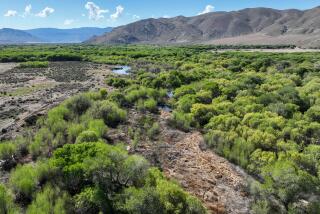Exploring ecosystems at science center
“Whoa! That’s so cool!” Julian Guzman shrieked as he spotted an image of wingless midge larvae.
Guzman, 9, was joined Tuesday by his fellow third-grade classmates from 32nd Street School for a sneak peak at the new permanent exhibition wing, Ecosystems, at the California Science Center in Exposition Park.
“We’re encouraging people to notice the science that exists all around them -- to look beyond these walls to notice and explore out in the real world,” said Jeffrey N. Rudolph, president and chief executive of the California Science Center. “It’s about engaging people -- particularly kids -- with the wonders of science.”
The new $165-million space, which officially opens Thursday, was 10 years in the making, occupies 45,000 square feet and contains more than 250 species of live plants and animals and hands-on science exhibits in 11 environments. (A small portion of the money for the Ecosystems wing went to refurbishing other exhibits.)
“We really want people to understand that complicated relations between the living world and the physical world are really interrelated and shaped by some of the same major rules of ecology,” said Diane Perlov, the center’s vice president of exhibits. “And through understanding the science of ecology, we feel people will become more conscious of the environment.”
“I love it,” an animated Guzman said. “It has lots of cool things to see and play with like. . .”
Before he could finish detailing what he admired in the Arctic versus Antarctic area, he was distracted by the commotion going on next door in the desert zone. He scurried across just in time for the flash-flood simulation. As the snarl of 3,500 gallons of water gushed through the fake canyon landscape, the children cheered -- “Aaah!” or “Oh, my God!”
But that’s not where the fun ended. A 188,000-gallon kelp tank is home to more than 1,500 live fish, kelp and other marine life. Interactive wind machines in the river zone demonstrate how air currents create rippling patterns on a wall of sequins. And over in the L.A. zone, visitors can explore how cities function as ecosystems.
-- Yvonne Villarreal






